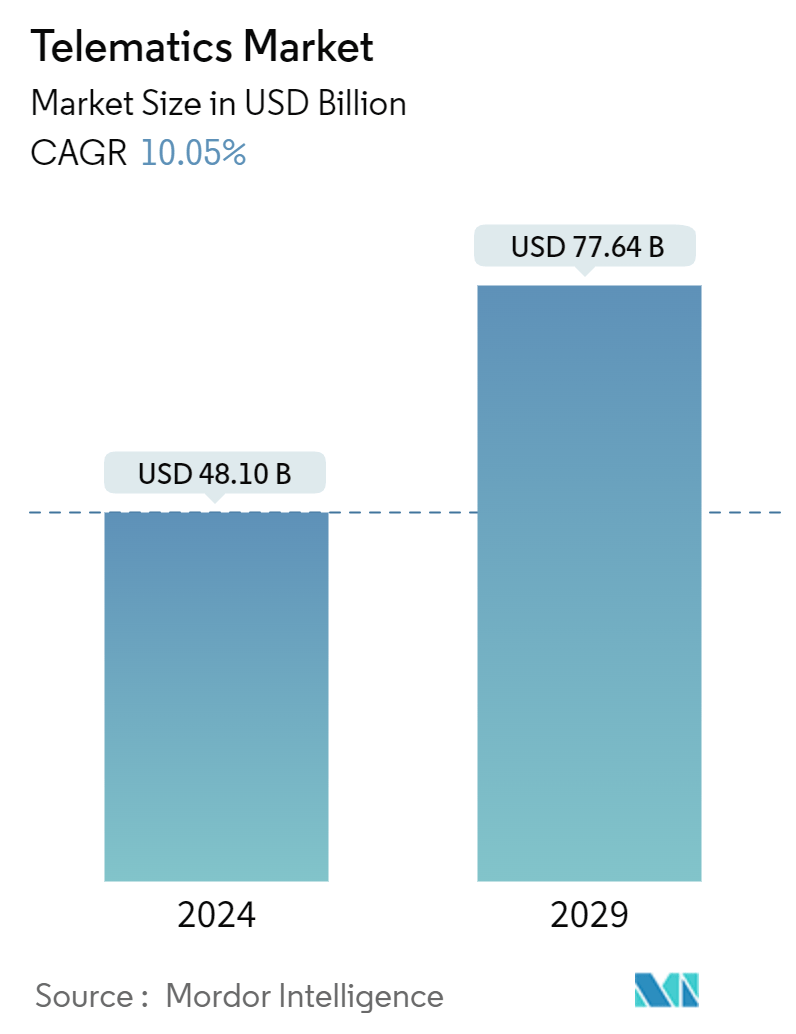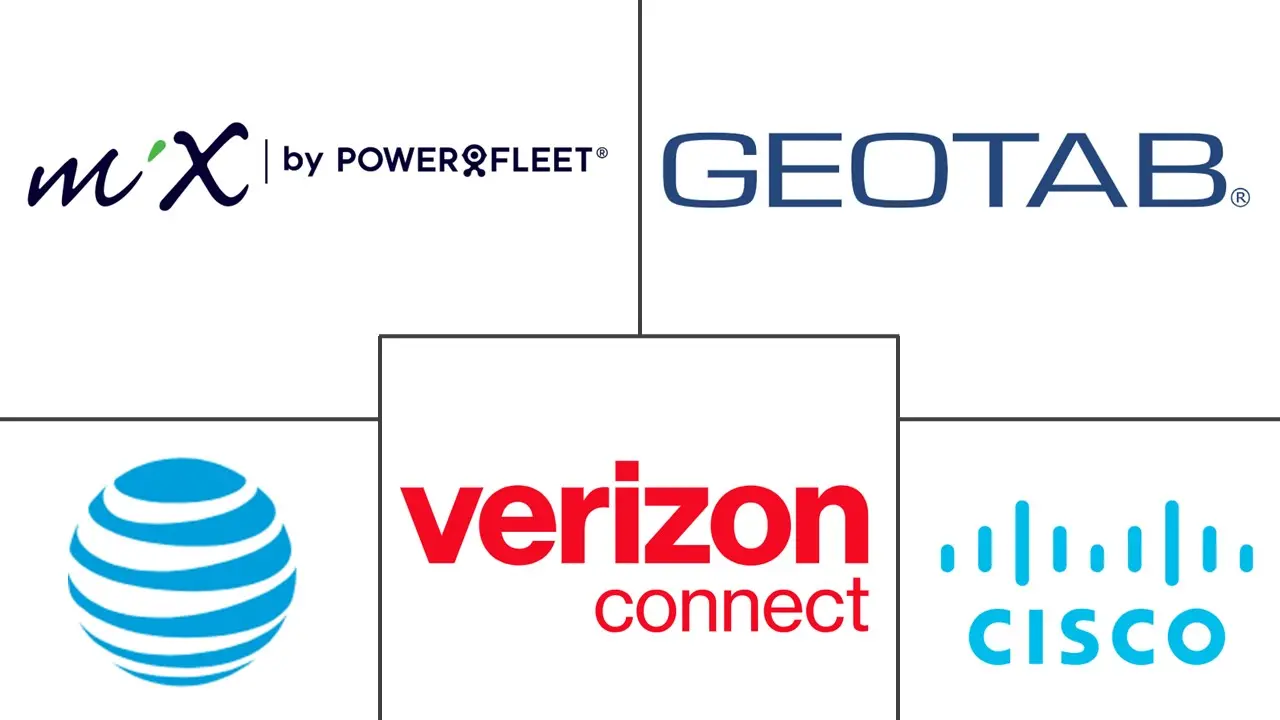Market Size of Telematics Industry

| Study Period | 2019 - 2029 |
| Market Size (2024) | USD 48.10 Billion |
| Market Size (2029) | USD 77.64 Billion |
| CAGR (2024 - 2029) | 10.05 % |
| Fastest Growing Market | Asia Pacific |
| Largest Market | North America |
Major Players
*Disclaimer: Major Players sorted in no particular order |
Telematics Market Analysis
The Telematics Market size is estimated at USD 48.10 billion in 2024, and is expected to reach USD 77.64 billion by 2029, growing at a CAGR of 10.05% during the forecast period (2024-2029).
The telematics market is a rapidly evolving sector within the automotive industry, driven by advancements in technology and rising demand for real-time data solutions. Telematics technology enables the transmission of data from vehicles to external systems, allowing companies to monitor and manage their fleets, track vehicle performance, and ensure safety and security. With the integration of Internet of Things (IoT) capabilities, telematics systems are becoming increasingly sophisticated, providing deeper insights into vehicle operations through data analytics. These solutions span across various applications such as fleet management, GPS tracking, and automotive insurance.
Key Players and Innovations in Telematics:
- Ongoing innovation: Key players like MiX Telematics, Geotab Inc., and Verizon Telematics are continuously innovating to offer more accurate and comprehensive data services, which are essential for businesses relying on vehicle operations.
- Consumer applications: Telematics technology is also gaining popularity among individual consumers, with original equipment manufacturers (OEMs) and aftermarket providers offering both embedded and portable devices. This surge in consumer interest is attributed to the increasing demand for enhanced safety features, vehicle diagnostics, and improved fuel efficiency.
- Cloud-based solutions: Additionally, cloud-based telematics solutions are growing in demand, allowing for seamless integration of telematics data with enterprise systems. This not only simplifies fleet management but also reduces operational costs.
Telematics Market Segmentation:
- OEMs and aftermarket players: The telematics market is segmented by the solutions provided by OEMs and aftermarket players, which include smartphone-based, portable, and embedded devices. These devices are tailored to meet the needs of diverse consumers, with entry-level, mid-tier, and high-end solutions available.
- Geographical markets: North America, Europe, and Asia-Pacific dominate the automotive telematics market. The widespread adoption is driven by stringent regulations concerning vehicle safety and efficiency, alongside rising consumer awareness of telematics technology benefits.
Surge in Connected Devices Expands Market Potential
- The rise of connected devices is significantly shaping the telematics market. With more vehicles now equipped with IoT-enabled telematics systems, data transmission between vehicles and infrastructure has become smoother and more efficient.
- Commercial telematics: This is particularly crucial for commercial telematics solutions, which rely on real-time data to manage large fleets. Companies benefit from optimized routing, fuel usage, and maintenance, thanks to the ability to monitor performance metrics and enhance operational efficiency.
- Consumer demand for connected vehicles: Connected car telematics is seeing substantial growth, with consumers increasingly opting for vehicles that offer advanced features like GPS tracking, real-time traffic updates, and emergency response capabilities. Smartphone-based telematics applications have further boosted this growth by providing consumers with easy access to vehicle data.
- Cloud-based platforms: The adoption of cloud-based telematics platforms has transformed vehicle management by allowing remote data access. These platforms provide scalability and adaptability, catering to the needs of diverse industries, from transportation to personal vehicle ownership.
Demand for Vehicle Diagnostics Fuels Technological Innovation
- The growing demand for seamless vehicle diagnostics is pushing advancements in telematics systems, particularly within fleet management.
- Fleet health monitoring: Companies managing large fleets require real-time vehicle health data to avoid costly breakdowns and reduce downtime. By using telematics data analytics, fleet managers can track key performance indicators such as engine health, fuel consumption, and tire pressure, enabling preventive maintenance.
- Proactive diagnostics: For consumers, telematics systems embedded in vehicles allow for proactive diagnostics, with automatic alerts for routine maintenance. This significantly reduces the risk of unexpected vehicle failures and enhances safety. These easy diagnostics tools are becoming an integral part of connected car applications, further fueling demand.
- Telematics innovation: The market continues to see innovations in telematics software and hardware as the demand for smarter, data-driven diagnostics grows, benefiting both commercial and personal vehicle owners.
Telematics Industry Segmentation
Telematics is a system with information technology and telecommunication capabilities that can be used extensively for monitoring remote and movable objects such as automobiles, including vehicles used for various industries' fleet transportation.
The telematics market is segmented by channel (OEM, aftermarket), by solution (smartphone, portable, and embedded), by offering type (hardware, services), and by geography (North America, Europe, Asia Pacific, Latin America, and Middle East and Africa). The market sizes and forecasts are provided for a value of USD for all the above segments.
| By Channel | |
| Original Equipment Manufacturers (OEM) | |
| Aftermarket |
| By Solution | |
| Smartphone | |
| Portable | |
| Embedded |
| By Offering Type | |
| Hardware | |
| Services (Entry-level, Mid-tier, High-end) |
| By Geography*** | |
| North America | |
| Europe | |
| Asia | |
| Australia and New Zealand | |
| Latin America | |
| Middle East and Africa |
Telematics Market Size Summary
The telematics industry is experiencing significant growth, driven by the integration of telecommunications and information technology to enhance data transmission and storage for remote object control. This sector has expanded its focus from vehicular analytics to encompass driver safety and personal service enhancements, leveraging advanced technologies to monitor driving behavior, vehicle health, and maintenance schedules. The automotive and industrial sectors are key drivers of this market expansion, with government initiatives promoting on-road safety further boosting demand. The rise of electric and autonomous vehicles, along with the development of applications like Advanced Driver Assistance Systems (ADAS) and Mobility-as-a-Service (MaaS), underscores the increasing need for robust telematics solutions. Despite challenges such as high installation costs and cybersecurity concerns, the market is poised for substantial growth.
In the Asia-Pacific region, the telematics market is highly competitive, with major players striving to innovate and enhance product relevance. The region's growth is fueled by the adoption of electric and autonomous vehicle technologies, which require advanced telematics for data transmission and analysis. Government regulations, such as mandatory Electronic Stability Control and Advanced Driver Assistance Systems, are further propelling market expansion. The global telematics market is semi-consolidated, with companies like AT&T, Verizon, and Cisco actively launching new solutions. Collaborations and partnerships, such as those between MiX Telematics and Hino Trucks, and Geotab and Free2move, are indicative of the market's dynamic nature and growth potential. The integration of smartphone telematics is also gaining traction, offering cost-effective solutions for usage-based insurance and enhancing driver safety through real-time monitoring.
Telematics Market Size - Table of Contents
-
1. MARKET DYNAMICS
-
1.1 Market Overview
-
1.2 Market Drivers
-
1.2.1 Rise in Connected Devices
-
1.2.2 Huge Demand of Easy Vehicle Diagnostics
-
-
1.3 Market Restraints
-
1.3.1 Threat of Data Breaches
-
1.3.2 High Costs Associated With Installations
-
-
1.4 Industry Value Chain Analysis
-
1.5 Industry Attractiveness - Porter's Five Forces Analysis
-
1.5.1 Threat of New Entrants
-
1.5.2 Bargaining Power of Buyers
-
1.5.3 Bargaining Power of Suppliers
-
1.5.4 Threat of Substitute Products
-
1.5.5 Intensity of Competitive Rivalry
-
-
1.6 Assessment of COVID-19 impact on the market
-
-
2. MARKET SEGMENTATION
-
2.1 By Channel
-
2.1.1 Original Equipment Manufacturers (OEM)
-
2.1.2 Aftermarket
-
-
2.2 By Solution
-
2.2.1 Smartphone
-
2.2.2 Portable
-
2.2.3 Embedded
-
-
2.3 By Offering Type
-
2.3.1 Hardware
-
2.3.2 Services (Entry-level, Mid-tier, High-end)
-
-
2.4 By Geography***
-
2.4.1 North America
-
2.4.2 Europe
-
2.4.3 Asia
-
2.4.4 Australia and New Zealand
-
2.4.5 Latin America
-
2.4.6 Middle East and Africa
-
-
Telematics Market Size FAQs
How big is the Telematics Market?
The Telematics Market size is expected to reach USD 48.10 billion in 2024 and grow at a CAGR of 10.05% to reach USD 77.64 billion by 2029.
What is the current Telematics Market size?
In 2024, the Telematics Market size is expected to reach USD 48.10 billion.

